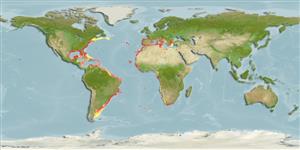>
Scombriformes (Mackerels) >
Scombridae (Mackerels, tunas, bonitos) > Scombrinae
Etymology: Scomber: Greek, skombros = tunny or mackerel, 1623 (Ref. 45335).
More on author: Gmelin.
Environment: milieu / climate zone / depth range / distribution range
Écologie
marin; saumâtre. Temperate; 46°N - 65°S, 98°W - 42°E
Atlantic Ocean. Warm water; eastern and western coasts, including the Mediterranean and southern Black Sea. Replaced by Scomber japonicus in the Indo-Pacific.
Length at first maturity / Taille / Poids / Âge
Maturity: Lm 21.3 range ? - ? cm
Max length : 55.0 cm TL mâle / non sexé; (Ref. 121850)
Adults and juveniles feed mainly on zooplankton, with relative importance of larger organisms such as cephalopods, crustaceans and small pelagic fish increases with the size of individuals. Caught mostly in purse seine and pelagic trawl fisheries which target sardine and/or anchovy. Usually a by-catch but when availability of target species is low, this species provided an alternative income (Ref. 121850)
Collette, B.B., 1999. Mackerels, molecules, and morphology. p. 149-164. In B. Séret and J.-Y. Sire (eds.) Proc. 5th Indo-Pac. Fish Conf., Noumea, Paris. (Ref. 33246)
Statut dans la liste rouge de l'IUCN (Ref. 130435: Version 2024-1)
Menace pour l'homme
Harmless
Utilisations par l'homme
Pêcheries: intérêt commercial mineur
Outils
Articles particuliers
Télécharger en XML
Sources Internet
Estimates based on models
Preferred temperature (Ref.
123201): 13.9 - 27.3, mean 22.5 °C (based on 492 cells).
Phylogenetic diversity index (Ref.
82804): PD
50 = 0.5625 [Uniqueness, from 0.5 = low to 2.0 = high].
Bayesian length-weight: a=0.00741 (0.00474 - 0.01159), b=3.04 (2.91 - 3.17), in cm total length, based on LWR estimates for this species & (Sub)family-body (Ref.
93245).
Niveau trophique (Ref.
69278): 3.9 ±0.63 se; based on food items.
Generation time: 4.5 (3.2 - 5.5) years. Estimated as median ln(3)/K based on 16
growth studies.
Résilience (Ref.
120179): Milieu, temps minimum de doublement de population : 1,4 à 4,4 années (Preliminary K or Fecundity.).
Prior r = 0.60, 95% CL = 0.39 - 0.90, Based on 6 data-limited stock assessments.
Fishing Vulnerability (Ref.
59153): Moderate vulnerability (42 of 100).
Nutrients (Ref.
124155): Calcium = 21.2 [8.1, 51.9] mg/100g; Iron = 0.69 [0.26, 1.60] mg/100g; Protein = 20.7 [19.5, 21.9] %; Omega3 = 0.739 [0.500, 1.145] g/100g; Selenium = 42.7 [22.3, 80.3] μg/100g; VitaminA = 20.1 [6.0, 80.7] μg/100g; Zinc = 0.688 [0.442, 1.014] mg/100g (wet weight); based on
nutrient studies.
